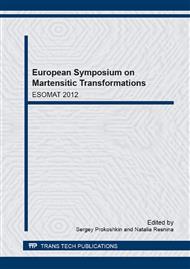[1]
P.T. Houldcroft, Submerged Arc Welding, 2nd ed., Abington Publishing, Cambridge, England, 1989.
Google Scholar
[2]
N. Murugan, V. Gunaraj, Prediction and control of weld bead geometry and shape relationships in submerged arc welding of pipes, J. of Mat. Proc. Technol. 168 (2005) 478–487.
DOI: 10.1016/j.jmatprotec.2005.03.001
Google Scholar
[3]
S. Kou, Welding Metallurgy, 2nd ed., John Wiley & Sons, Inc., Hoboken, New Jersey, 2003.
Google Scholar
[4]
K. Prasad, D. K. Dwivedi, Some investigations on microstructure and mechanical properties of submerged arc welded HSLA steel joints, Int. J. Adv. Manuf. Technol. 36 (2008) 475–483.
DOI: 10.1007/s00170-006-0855-1
Google Scholar
[5]
S. Jindal, R. Chhibber, N.P. Mehta, Issues in Welding of HSLA Steels, Advanced Materials Research. 365 (2012) 44-49.
DOI: 10.4028/www.scientific.net/amr.365.44
Google Scholar
[6]
D. Bhandari, R. Chhibber, N. Arora, Effect of Electrode Coatings on Diffusible Hydrogen Content, Hardness and Microstructures of the Ferritic Heat Affected Zones in Bimetallic Welds, Advanced Materials Research. 383-390 (2011) 4697-4701.
DOI: 10.4028/www.scientific.net/amr.383-390.4697
Google Scholar
[7]
N.D. Pandey, A. Bharti, S.R. Gupta, Effect of submerged arc welding parameters and fluxes on element transfer behaviour and weld-metal chemistry, J. Mater. Process. Technol. 40 (1994) 195-211.
DOI: 10.1016/0924-0136(94)90486-3
Google Scholar
[8]
P. Kanjilal, T.K. Pal, S.K. Majumdar, Combined effect of flux and welding parameters on chemical composition and mechanical properties of submerged arc weld metal, J. Mater. Process. Technol. 171 (2006) 223–231.
DOI: 10.1016/j.jmatprotec.2005.06.083
Google Scholar
[9]
R. S. Chandel, The Effect of Process Variables on the Flux Consumption in Submerged Arc Welding, Mater. Manuf. Processes. 13-2 (1998) 181-188.
DOI: 10.1080/10426919808935234
Google Scholar
[10]
P. Kanjilal, S. K. Majumdar, T.K. Pal, Prediction of Acicular Ferrite from Flux Ingredients in Submerged Arc Weld Metal of C-Mn Steel, ISIJ International. 45-6 (2005) 876-885.
DOI: 10.2355/isijinternational.45.876
Google Scholar
[11]
J. E. Ramirez, Characterization of High-Strength Steel Weld Metals: Chemical Composition, Microstructure, and Nonmetallic Inclusions, Weld J. 87 (2008) 65s-75s.
Google Scholar
[12]
S. Datta, A. Bandyopadhyay, P. K. Pal, Application of Taguchi philosophy for parametric optimization of bead geometry and HAZ width in submerged arc welding using a mixture of fresh flux and fused flux, Int. J. Adv. Manuf. Technol. 36 (2008) 689-698
DOI: 10.1007/s00170-006-0894-7
Google Scholar
[13]
S. Datta, G. Nandi, A. Bandyopadhyay, P. K. Pal, Application of PCA-based hybrid Taguchi method for correlated multicriteria optimization of submerged arc weld: a case study, Int. J. Adv. Manuf. Technol. 45 (2009) 276 – 286.
DOI: 10.1007/s00170-009-1976-0
Google Scholar
[14]
E. Bauné, C. Bonnet, S. Liu, Reconsidering the basicity of a FCAW consumable-Part 2: Verification of the Flux/Slag analysis methodology for Weld Metal Oxygen Control, Welding Research Supplement. (2000) 66-71.
Google Scholar
[15]
R. K. Roy, Design of experiments using the Taguchi approach, John Wiley & Sons, 2001.
Google Scholar


